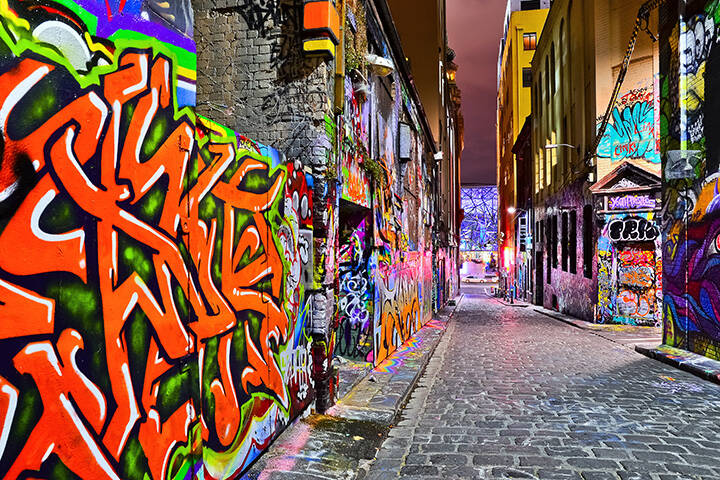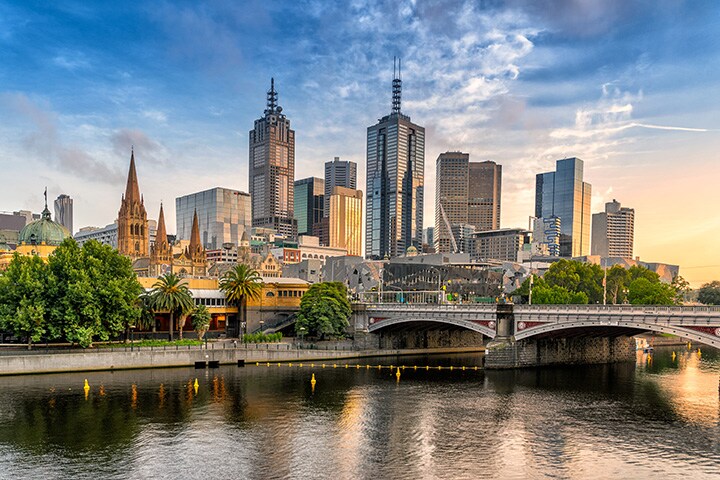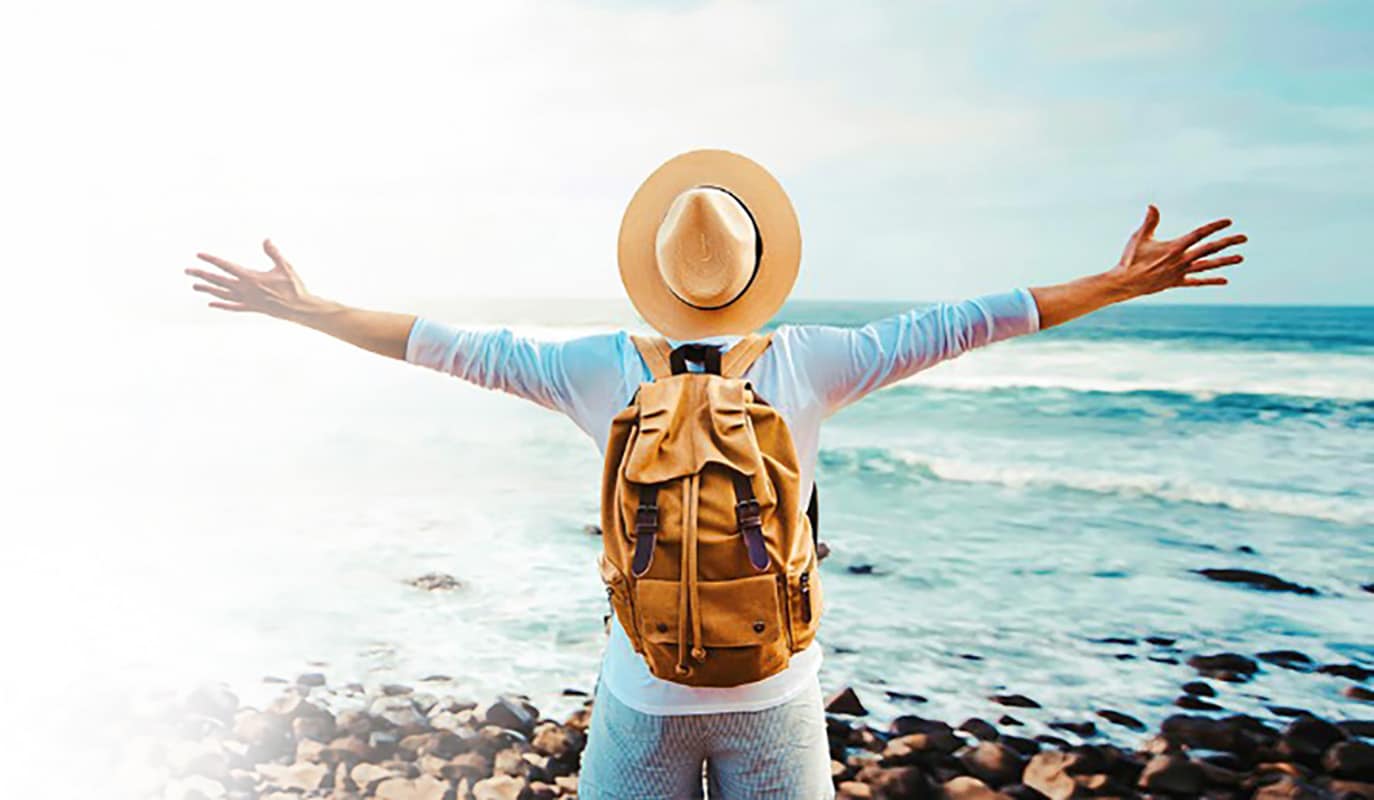Boasting a vibrant culture, an effortless cool factor, and some of the nation's best coffee, Melbourne is a holiday destination like no other.
Melbourne, the capital of Victoria, is renowned for its eclectic neighbourhoods, hidden laneway bars, and a rich sporting and arts culture. From the iconic Flinders Street Station and Federation Square to the bustling Queen Victoria Market and picturesque Yarra River, the city offers something for every traveller. Whether you’re visiting for the coffee, the culture, or its famous events like the Australian Open and Melbourne Cup, our Melbourne travel guide will help you plan the perfect trip.
Popular flights to Melbourne
Frequently asked questions about travelling to Melbourne
-
When is the best time of year to visit Melbourne?
There’s never a bad time to visit Melbourne, but generally, the best times to visit Melbourne are between March and May (autumn), and September to November (spring), as the temperatures are mild, there are less tourists, and there’s a better chance to great deals on flights and accommodation.
Summer (December to February) is a great time to visit Melbourne to enjoy outdoor events, like the Australian Open, and beach days along the coast, while winter (June to August) is perfect for those who enjoy cozy cafés and cultural experiences - plus it’s typically the cheapest time to visit Melbourne!
Read our guide on the best times to visit Melbourne depending on your priorities and preferences.
-
How many days do you need to visit Melbourne?
Three days in Melbourne should give you enough time to get a good taste of the city’s vibrant culture, key attractions, famous laneways and famous food culture. Staying for a bit longer for 5-7 days allows more time to explore more of the city and beyond, including the Great Ocean Road, Yarra Valley, or Mornington Peninsula
-
What is the weather like in Melbourne?
Melbourne’s weather is famously unpredictable, and you can easily experience four seasons in one day. Officially – according to the Köppen climate classification Cfb – Melbourne has a temperate ocean climate and is known to experience mild, dry winters and warm, humid summers. If you want to know what to expect for each season, here’s a quick breakdown:
- Summer (Dec–Feb): Warm to hot, with average temperatures between 14°C and 27°C.
- Autumn (Mar–May): Mild and pleasant, with temperatures from 10°C to 25°C.
- Winter (Jun–Aug): Cool and sometimes rainy, with temperatures between 8°C and 15°C.
- Spring (Sep–Nov): A mix of sunshine and showers, with temperatures ranging from 9°C to 23°C.
That said, it’s always a good idea to pack some layers and an umbrella to be prepared for any kind of weather conditions.
Read more in our guide to Melbourne’s weather and climate.
-
What to pack for a trip to Melbourne?
No matter when you’ve booked your trip to Melbourne, it’ll always be useful to pack light layers to be prepared for the city’s famous unpredictable weather. We also recommend comfortable walking shoes, sunglasses and a jacket.
A trip during summer will call for lightweight clothing in breathable materials, while a thick, warm coat and a scarf should be packed for a winter trip.
-
What are the best areas to stay in Melbourne?
Where you stay in Melbourne depends on who you’re travelling with, your interests and travel priorities. Here are some of the best areas:
- For first-time visitors: Melbourne CBD or Southbank
- For nightlife and dining: Fitzroy, Collingwood, Melbourne CBD, South Yarra or St Kilda
- For families: Southbank or Docklands
- For a local vibe: Carlton or Fitzroy
- For business travel: Melbourne CBD or South Bank
- For luxury stays: South Yarra or East Melbourne
- For coffee connoisseurs: Brunswick or Carlton
Read more on the best areas to stay in Melbourne.
-
What are the top attractions in Melbourne?
Whether you’re an avid sports fan, an architecture fiend or a self-confessed art aficionado, Melbourne has attractions to suit every traveller. Here are some of the top attractions to visit in Melbourne:
- Federation Square
- Flinders Street Station
- Hosier Lane
- Royal Botanic Gardens
- Melbourne Cricket Ground
- Queen Victoria Market
- National Gallery of Victoria
- Melbourne Skydeck
- St Kilda Beach
- Melbourne Museum
Check out more top attractions in Melbourne.
-
What are the best free things to do in Melbourne?
There are so many fun things to do that won’t cost a cent. Some our favourite free things to do in Melbourne are:
- Exploring the Royal Botanic Gardens
- Going to an exhibition at the National Gallery of Victoria (NGV)
- Taking a moment at the Shrine of Remembrance
- Riding the City Circle Tram
- Checking out the street art and graffiti in the city’s arcades and laneways
- Watching the sunset at St Kilda Beach
- Joining a free walking tour
- Walking along the Yarra River at South Bank
- Sampling the free tasters at the Queen Victoria Markets
- Checking out the architecture of the Block Arcade
Read more on the best free things to do in Melbourne, as well as our guide to all the best things to do in Melbourne.
-
Where to find the best coffee in Melbourne?
It may be harder to find a bad coffee in Melbourne! Some of the best places to get a next-level cup of coffee include:
- Proud Mary (Collingwood)
- Market Lane Coffee (Various locations)
- Patricia Coffee Brewers (CBD)
- Dukes Coffee Roasters (CBD)
- St ALi (Various locations)
- Seven Seeds (Carlton)
- Wide Open Road (Brunswick)
-
What are the best day trips from Melbourne?
Some of the best day trips from Melbourne include:
- Great Ocean Road: A stunning coastal drive, the Twelve Apostles, and beautiful beaches
- Yarra Valley: Perfect for wine-tasting and gourmet food experiences
- Phillip Island: A unique experience to see the Penguin Parade and coastal scenery
- Mornington Peninsula: Hot springs, wineries, and beautiful beaches – what more could you want?
- Dandenong Ranges: A quiet escape for rainforest walks and the Puffing Billy steam train
Read more on the best day trips from Melbourne.
-
Are there any wine regions near Melbourne?
Yes! There are afew wine regions within a short drive from Melbourne city. The most popular wine regions near Melbourne are Yarra Valley (1 hour from Melbourne) and Mornington Peninsula (1 – 1.5 hours from Melbourne).
-
What is the best way to get around Melbourne?
Melbourne has a comprehensive and well-connected public transport system, making it one of the best ways to get around the city. Trams are the most popular (and the Free Tram Zone covers most of the CBD!), while trains and buses can help get you to the suburbs and beyond. Taxis and rideshare are also readily available, while the grid-like layout of the city makes it easy to navigate for those driving in a rental car – just watch out for the hook turns in the city.
Read more on getting around Melbourne.
-
Do I need a myki card to use public transport in Melbourne?
Yes, if you plan to use trains, buses, or trams outside the Free Tram Zone, you’ll need a myki card. You can buy a myki car at train stations, some tram stops, 7-Eleven stores, and online.
-
Is Melbourne a walkable city?
Yes! Melbourne is one of Australia’s most walkable cities with a compact CBD, pedestrian-friendly streets, and plenty of laneways to explore. For longer distances, use tity's train, bus and tram system or you can get a taxi or rideshare service easily.








